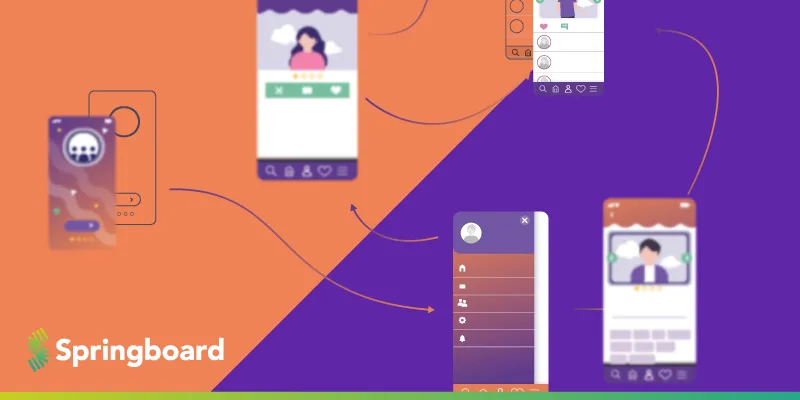
Springboard
View Brand PublisherWhy UI/UX design is crucial to helping businesses succeed in today’s world
UI/UX designers need the right skills to put the user’s needs first when designing products
In 1971, Walt Disney World opened its doors to the public for the first time. ‘The happiest place on earth’ was founded on its eponymous founder’s vision of how the ‘ latest technology can be used to improve the lives of people’. He wanted to create an immersive experience that was designed down to the last detail to bring joy to visitors. Little wonder then that many consider him the world’s first user experience (UX) designer.
The term “user experience design” was coined many years later when cognitive scientist Donald Norman joined Apple in 1993 as a User Experience Architect. He became the first person ever to have a UX job title.
He said, “I invented the term because I thought human interface and usability were too narrow: I wanted to cover all aspects of the person’s experience with a system, including industrial design, graphics, the interface, the physical interaction, and the manual.”
Today, UX design is an integral part of our lives - invisible and yet obvious. It’s in the satisfaction we feel in a seamless online shopping experience, the sense of wonder that compels us to reach for a product that we want but don’t really need, and the annoyance we feel when halfway through a Friday night at the pub, the over-clever washroom signs leave us wondering which door we should choose.
At its core, UX is fundamentally about the usability of an application or user interface (UI). It includes software design and development, branding, functionality, design, integration, and usability. This means that it’s not just about creating products that work – it’s about the happiness that customers feel through the entire journey of acquiring the product to finally using it.
It’s also important to highlight the subtle distinction between UI and UX. While both are crucial aspects of the same journey, UI design, which is a subset of the whole UX journey, is how a person interacts with a product and UX is how that interaction made them feel.

Differentiated and impactful experiences
With more companies vying to get consumers’ attention today, there is a growing demand for good UI/UX designers. According to the ‘25 Highest-paying Entry-level Jobs 2019’ report by Glassdoor, UX designers were in sixth place. LinkedIn listed it as one of the 10 most in-demand skills for 2020. In India alone, it is estimated that 1,500 to2,000 UI/UX design jobs for junior designers are added each month. However, despite encouraging factors like the growing prevalence of a gig economy, the high demand for UI/UX designers and how lucrative the jobs are (UI/UX professionals in India are paid on par with their peers in the UK), when it comes to qualified professionals who can fill these positions. there still exists a significant skill gap. In fact, this skill gap is something that has impacted India’s economy as a whole. A recent skill gap analysis by the Government of India concluded that by 2022, approximately, 109 million more skilled workers would be needed in 24 key sectors. of the economy.
While design courses in India are not uncommon, with several universities offering traditional courses, UI/UX design is a relatively new field, requiring very specific skill sets such as the ability to research and empathise with the end-user; collaboration skills; the ability to visualise; wireframe and prototype design; the ability to communicate, and some knowledge of coding.
San-Francisco based learning platform , which entered the Indian market in January 2019, recently added a UI/UX Design Career Track to its existing bouquet of online courses for the Indian market
"We have all heard how data is the new oil. Design is the spark for this oil, and an integral part of the digital transformation our world is going through. We believe India can replicate its success as the world’s IT Hub, to become the Design Hub of the world in the near future. Research shows that each month, 2,000 new job openings are available in the country for junior UI/UX designers. There is a palpable need in India for quality design education for those who haven’t studied design as their first-degree. And that is what we are aiming to provide. ," says Vivek Kumar, MD, India Business.
Designed to succeed
The course, which is driven by hands-on learning and 1:1 mentorship, features lots of exercises and mini-projects where students can practice their learning - be it colour or typography or user research, and information architecture. The course is split into nine major modules and includes career counselling to prepare the student for the job market. What makes the course structure unique is that the learning is not static. Each student gets a mentor who works with them in a 360-degree learning model. This means that there is always someone to assist the student right from the learning process to getting a job.
Springboard follows a unique mentor-matching process where students fill out a profile, which includes information about their background, their availability during the week, and the skills they want to develop. Student advisors then use this information to match the student with the ideal mentor who suits their specific needs. Thrice a month, students and mentors get on a call to receive feedback on projects, answer questions about the curriculum, and get career advice and industry insights.
Additionally, student advisors are available to help students prepare for the course, and answer course-related questions. Springboard also has community managers who answer questions about the curriculum and the UI/UX industry. Finally, career coaches help students find the ideal job by teaching networking skills and how to create a strong resume.
"Online learning can feel very lonely. However, the uniqueness of Springboard's pedagogy is the human touch it provides to all its course offerings. Each student is matched 1:1 with a mentor who is a leading industry professional. Whether it's discussing industry trends, helping students progress in the curriculum, or giving feedback on projects, a mentor guides his or her mentee throughout the learning journey. Our UI/UX design mentors are professionals working at top companies like Microsoft, Google, Accenture, Adobe, PayTM, Virtusa, etc. A lot of our mentors also own independent design studios where they work with renowned brands," says Nidhi Gupta, Program Director, Design Programs.
Springboard design courses in the US have received significant interest. Over 850,000 students have enrolled in the Design Career Track since its launch in 2018. Graduates reported a $19,600 average salary increase from before to after the course. The team is optimistic about replicating that success in India.
“We are confident that through our curriculum and pedagogy, we will make our learners fit for the industry requirements within nine months. Our students graduate with a solid design portfolio they can showcase to prospective employers. We offer career coaching to help students learn the strategies to look for the right jobs and excel at interviews. A junior designer can earn anywhere between Rs 5-9 lakhs per annum and senior designers can command salaries at par with data scientists," says Nidhi.
"In a world where humans spend a large part of their day looking at their screens (phones, computers, TVs), products/services that provide a good digital experience to their users will be the ones that will stand out among the competition,” says Vivek.
YourStory is offering its readers a unique opportunity to be a part of this exciting new job space with a Webinar titled Pillars of Design. Sign up now.









